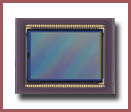
Canon 1D MK II Preview |
 |
1. Introduction |  |
| 2. MK II Sensor.. | ||
| 3. 1D vs. 1D MK II |
Canon 1D MK II |
||||||||
The Sensor |
||||||||
 The new sensor in the 1D MK II is twice the resolution of the original 1D. It's also a new CMOS sensor altogether. The recording resolution (the information you actually see) of the MK II sensor is 3520 x 2336. The pixel size (aka, Pixel Pitch) has remained fairly large, measuring 8.2 microns square. Canon even says this sensor has less noise than it's 1Ds sensor, and comments the microlenses "have much smaller gaps between them than those on the 1Ds." There are rumors of a 1Ds MK II coming later this year, or sometime in the near future, and I think this is very likely. You don't compare a $4500 DSLR to a $7000 DSLR, if you don't have anything new coming down the line. The new sensor in the 1D MK II is twice the resolution of the original 1D. It's also a new CMOS sensor altogether. The recording resolution (the information you actually see) of the MK II sensor is 3520 x 2336. The pixel size (aka, Pixel Pitch) has remained fairly large, measuring 8.2 microns square. Canon even says this sensor has less noise than it's 1Ds sensor, and comments the microlenses "have much smaller gaps between them than those on the 1Ds." There are rumors of a 1Ds MK II coming later this year, or sometime in the near future, and I think this is very likely. You don't compare a $4500 DSLR to a $7000 DSLR, if you don't have anything new coming down the line. |
||||||||
Dynamic ISO Range |
||||||||
ISO range of the MK II has increased. You can adjust the ISO 100-1600 levels in 1/3 increments, while manually selecting ISO 50 or ISO 3200. The original 1D had ISO 200-3200, and the added lower ISO range in the new sensor, gives us an indication we have an integrated sensor which can meet the demands of not only sports journalists, but studio photographers as well. It is apparent the 1Ds is on its way to competing with the Medium Format crowd, and the 1D MK II will be Canon's "2-in-1" professional DSLR, satisfying almost any current photographic need. |
||||||||
Extremely Low Noise |
||||||||
Second-generation noise reducing circuitry is alongside the MK II sensor. I have only seen a few samples posted so far, but they look very promising. It would be nice to show you just how good the images appear to be, but I am sure Canon would want them taken down, even though these images would be clearly marked Pre-Production. I can see their point. In any case, expect several new samples to appear on the net in the next month, so you shouldn't have too much of a time trying to find examples. Visit any of the photography forums on the net and I'm sure links will be posted to those samples. Obviously, they won't last for long, because Canon does not want pre-production images on the net. It will most likely be about a month or so before we see any images which will stay on a website for longer than a period of a few days. |
||||||||
Noise has been reduced even further in the 1D. Even if Nikon's D2h was getting close to the 1D's noise levels, forget about it now. The MK II has separate circuitry and the signal paths of the internal wiring have been shortened. DFS (Dark Frame Substraction) is used for extended exposure times. The benefits of Canon's CMOS sensor are going to really pay off here. Since CMOS requires less power, noise levels are inherently lower. |
||||||||
 |
1. Introduction |  |
| 2. MK II Sensor.. | ||
| 3. 1D vs. 1D MK II |
|
|